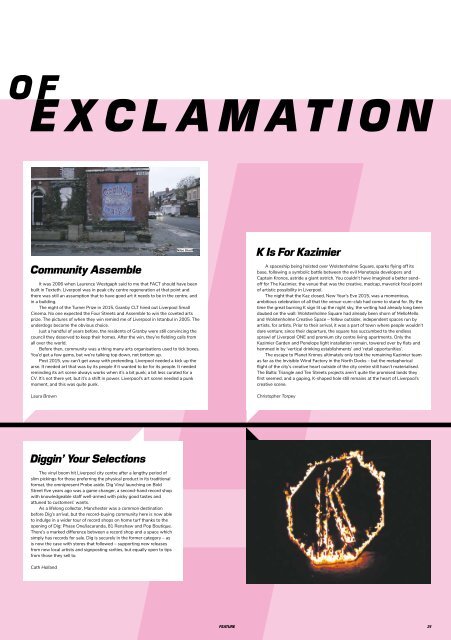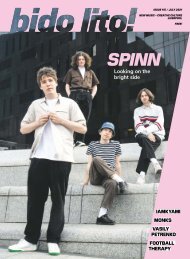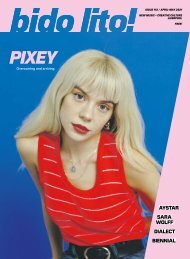Issue 106 / Dec 2019/Jan 2020
December 2019/January 2020 double issue of Bido Lito! magazine. Featuring: BEIJA FLO, ASOK, LO FIVE, SIMON HUGHES, CONVENIENCE GALLERY, BEAK>, STUDIO ELECTROPHONIQUE, ALEX TELEKO, SHE DREW THE GUN, IMTIAZ DHARKER and much more.
December 2019/January 2020 double issue of Bido Lito! magazine. Featuring: BEIJA FLO, ASOK, LO FIVE, SIMON HUGHES, CONVENIENCE GALLERY, BEAK>, STUDIO ELECTROPHONIQUE, ALEX TELEKO, SHE DREW THE GUN, IMTIAZ DHARKER and much more.
Create successful ePaper yourself
Turn your PDF publications into a flip-book with our unique Google optimized e-Paper software.
OF<br />
EXCLAMATION<br />
Community Assemble<br />
It was 2006 when Laurence Westgaph said to me that FACT should have been<br />
built in Toxteth. Liverpool was in peak city centre regeneration at that point and<br />
there was still an assumption that to have good art it needs to be in the centre, and<br />
in a building.<br />
The night of the Turner Prize in 2015, Granby CLT hired out Liverpool Small<br />
Cinema. No one expected the Four Streets and Assemble to win the coveted arts<br />
prize. The pictures of when they win remind me of Liverpool in Istanbul in 2005. The<br />
underdogs become the obvious choice.<br />
Just a handful of years before, the residents of Granby were still convincing the<br />
council they deserved to keep their homes. After the win, they’re fielding calls from<br />
all over the world.<br />
Before then, community was a thing many arts organisations used to tick boxes.<br />
You’d get a few gems, but we’re talking top down, not bottom up.<br />
Post 2015, you can’t get away with pretending. Liverpool needed a kick up the<br />
arse. It needed art that was by its people if it wanted to be for its people. It needed<br />
reminding its art scene always works when it’s a bit punk; a bit less curated for a<br />
CV. It’s not there yet, but it’s a shift in power. Liverpool’s art scene needed a punk<br />
moment, and this was quite punk.<br />
Laura Brown<br />
Niloo Sharifi<br />
K Is For Kazimier<br />
A spaceship being hoisted over Wolstenholme Square, sparks flying off its<br />
base, following a symbolic battle between the evil Monotopia developers and<br />
Captain Kronos, astride a giant ostrich. You couldn’t have imagined a better sendoff<br />
for The Kazimier, the venue that was the creative, madcap, maverick focal point<br />
of artistic possibility in Liverpool.<br />
The night that the Kaz closed, New Year’s Eve 2015, was a momentous,<br />
ambitious celebration of all that the venue-cum-club had come to stand for. By the<br />
time the great burning K sign lit up the night sky, the writing had already long been<br />
daubed on the wall: Wolstenholme Square had already been shorn of MelloMello<br />
and Wolstenholme Creative Space – fellow outsider, independent spaces run by<br />
artists, for artists. Prior to their arrival, it was a part of town where people wouldn’t<br />
dare venture; since their departure, the square has succumbed to the endless<br />
sprawl of Liverpool ONE and premium city centre living apartments. Only the<br />
Kazimier Garden and Penelope light installation remain, towered over by flats and<br />
hemmed in by ‘vertical drinking establishments’ and ‘retail opportunities’.<br />
The escape to Planet Kronos ultimately only took the remaining Kazimier team<br />
as far as the Invisible Wind Factory in the North Docks – but the metaphorical<br />
flight of the city’s creative heart outside of the city centre still hasn’t materialised.<br />
The Baltic Triangle and Ten Streets projects aren’t quite the promised lands they<br />
first seemed, and a gaping, K-shaped hole still remains at the heart of Liverpool’s<br />
creative scene.<br />
Christopher Torpey<br />
Diggin’ Your Selections<br />
The vinyl boom hit Liverpool city centre after a lengthy period of<br />
slim pickings for those preferring the physical product in its traditional<br />
format, the omnipresent Probe aside. Dig Vinyl launching on Bold<br />
Street five years ago was a game changer, a second-hand record shop<br />
with knowledgeable staff well-armed with picky good tastes and<br />
attuned to customers’ wants.<br />
As a lifelong collector, Manchester was a common destination<br />
before Dig’s arrival, but the record-buying community here is now able<br />
to indulge in a wider tour of record shops on home turf thanks to the<br />
opening of Dig: Phase One/Jacaranda, 81 Renshaw and Pop Boutique.<br />
There’s a marked difference between a record shop and a space which<br />
simply has records for sale. Dig is securely in the former category – as<br />
is now the case with stores that followed – supporting new releases<br />
from new local artists and signposting rarities, but equally open to tips<br />
from those they sell to.<br />
Cath Holland<br />
FEATURE<br />
31

















